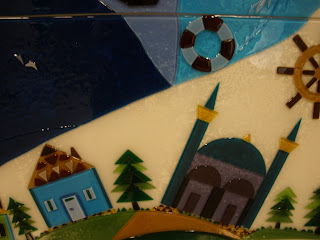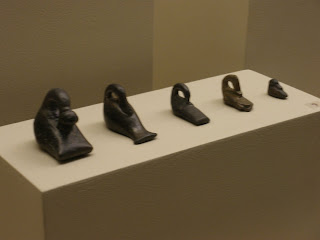Turkey is one of the largest tea drinking countries in the world. Tea is offered at restaurants and cafes and is also made in the home. Traditionally, it is served in small glasses with a saucer and sugar on the side. Never is milk or lemon used in tea. A glass of tea is often just 50 cents. This one had a view of the Bosphorus, right by the ferry terminal, so it cost $2. The process of making Turkish tea is an art I have yet to acquire. It takes about a half an hour and a double boiler type tea pot is needed. Initially, you boil water in the bottom kettle and just have the loose tea leaves in the top kettle. After the water boils, some water from the bottom kettle is poured into the top kettle to wet the tea leaves. Then the steeping process starts. More boiling water is added to the top as needed. After 30 minutes, you have some very strong (and I find bitter) tea in the top kettle. The server then pours tea from the top kettle into a glass and adds water from the bottom kettle to get the right color and strength.
The process of making Turkish tea is an art I have yet to acquire. It takes about a half an hour and a double boiler type tea pot is needed. Initially, you boil water in the bottom kettle and just have the loose tea leaves in the top kettle. After the water boils, some water from the bottom kettle is poured into the top kettle to wet the tea leaves. Then the steeping process starts. More boiling water is added to the top as needed. After 30 minutes, you have some very strong (and I find bitter) tea in the top kettle. The server then pours tea from the top kettle into a glass and adds water from the bottom kettle to get the right color and strength.  In the food stores, there are many brands of tea and the most popular packaging is the one kilo (2.2045 pounds) size. That's a lot of tea! And a great bargain...prices for a kilo of tea range from $6 to $8. Tea is grown in the north of Turkey, near the Black Sea.
In the food stores, there are many brands of tea and the most popular packaging is the one kilo (2.2045 pounds) size. That's a lot of tea! And a great bargain...prices for a kilo of tea range from $6 to $8. Tea is grown in the north of Turkey, near the Black Sea.
 So when two workers arrived at my apartment with our two night tables each in a box containing 17 convenient pieces, I felt I needed to offer drinks. Coffee, tea or water? One chose water and the other tea. I turned on the electric kettle, boiled up some water and poured it over a Dilmah Ceylon Supreme Tea bag, imported in one of my three suitcases and purchased at the Giant in Nazareth, PA. Well, what could the worker expect from a foreigner? As it turns out, he thought it was an excellent cup of tea and inquired as to the type of tea. Maybe he does not care for the traditional tea's bitterness either. Or maybe it was the packet of Equal I gave him that made it special, as I did not have any sugar in the house.
So when two workers arrived at my apartment with our two night tables each in a box containing 17 convenient pieces, I felt I needed to offer drinks. Coffee, tea or water? One chose water and the other tea. I turned on the electric kettle, boiled up some water and poured it over a Dilmah Ceylon Supreme Tea bag, imported in one of my three suitcases and purchased at the Giant in Nazareth, PA. Well, what could the worker expect from a foreigner? As it turns out, he thought it was an excellent cup of tea and inquired as to the type of tea. Maybe he does not care for the traditional tea's bitterness either. Or maybe it was the packet of Equal I gave him that made it special, as I did not have any sugar in the house.
Enjoy your next cup of tea!
 A closeup of some houses, a ferry boat and a mosque...
A closeup of some houses, a ferry boat and a mosque...














































